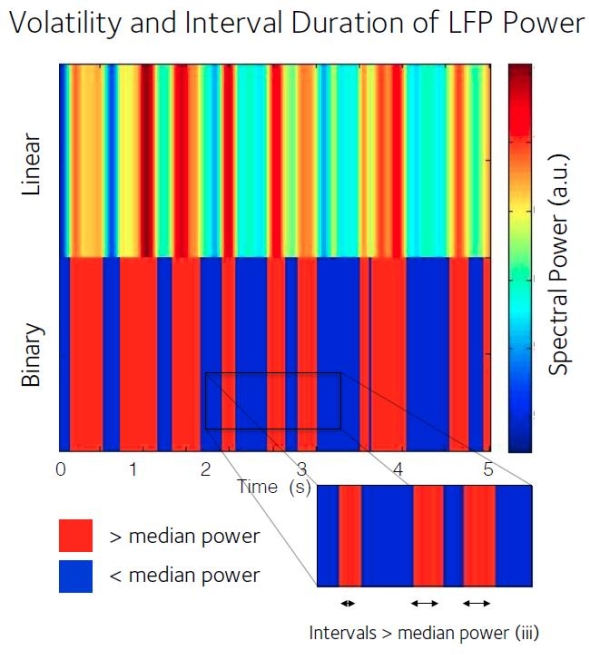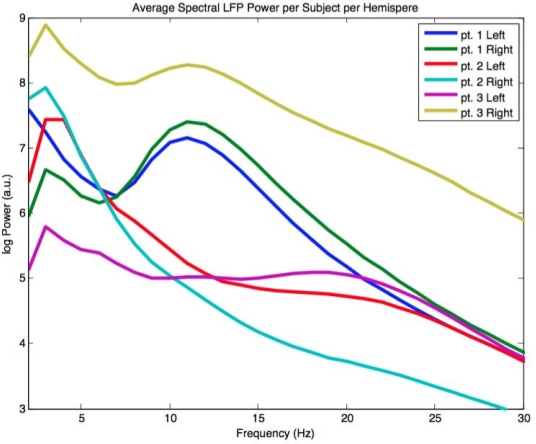Session Information
Date: Thursday, June 23, 2016
Session Title: Dystonia
Session Time: 12:00pm-1:30pm
Location: Exhibit Hall located in Hall B, Level 2
Objective: To assess the occurrence and volatility of 4-12 Hz oscillations in local field potentials (LFPs) recorded in the internal globus pallidus (GPi) of dystonia patients.
Background: Increased LFP power in the 4-12 Hz range has been observed in dystonia patients treated with deep brain stimulation (DBS). The power correlates with the severity of mobile dystonia and it specifically decreases with the application of DBS. As such, the power or volatility of 4-12 Hz oscillations can be used as a feedback signal for adaptive DBS (aDBS). This might lead to better efficacy and less side-effects of DBS treatment.
Methods: Bipolar LFPs were obtained from three dystonia patients directly after the implantation of bilateral DBS-electrodes in the GPi. Frequency spectra were obtained using Morlet wavelet transformations with a temporal resolution of 25 ms over approximately one minute. For each GPi registration (n=6), the LFP with the highest value in the 4-12 Hz range was used for further analyses. This included average 4-12 Hz and 13-30 Hz, log-transformed, power (i), coefficient of variation (CV, ii) and average interval length above the median power value. The CV indicates the volatility of the LFP power, whereas the interval length above the median power indicates for how long increased LFP power persists (iii, figure 1) 
Results: Within the 4-12 Hz range, the maximum LFP power was at 11 Hz (figure 2). Average 4-12 Hz power (6.16 ± 0.85) was significantly higher (T5 = 5.12, p = 0.001) compared to the 13 – 30 Hz power (4.47 ± 1.12) at the same bipolar LFP. CV values were significantly (T5 = 5.34, p = 0.003) higher for 13 – 30 Hz power (23 ± 5%) compared to the 4-12 Hz power (15 ± 2%). Finally, the interval length above median power for 4-12 Hz power was significantly longer (T5 = 6.04, p = 0.001) than for 13-30 Hz power, respectively 341 ± 82 ms and 145 ± 16 ms. 
Conclusions: The LFP power of 4-12 Hz GPi-oscillations in dystonia is less volatile than 13-30 Hz oscillations in the same region. Also, substantial LFP power changes occur less often in 4-12 Hz compared to 13-30 Hz oscillations. These findings support future development of 4-12 Hz oscillations as feedback signal for aDBS in dystonia. This can be applied as a trigger for the DBS to be switched on in case the amplitude of 4-12 Hz oscillation power reaches a critical threshold.
To cite this abstract in AMA style:
D.A.I. Pina-Fuentes, J.C. van Zijl, J.W. Elting, G. Drost, J.M. van Dijk, M.A. Tijssen, M. Beudel. Temporal dynamics of pallidal low-frequency oscillations in dystonia [abstract]. Mov Disord. 2016; 31 (suppl 2). https://www.mdsabstracts.org/abstract/temporal-dynamics-of-pallidal-low-frequency-oscillations-in-dystonia/. Accessed December 12, 2025.« Back to 2016 International Congress
MDS Abstracts - https://www.mdsabstracts.org/abstract/temporal-dynamics-of-pallidal-low-frequency-oscillations-in-dystonia/
